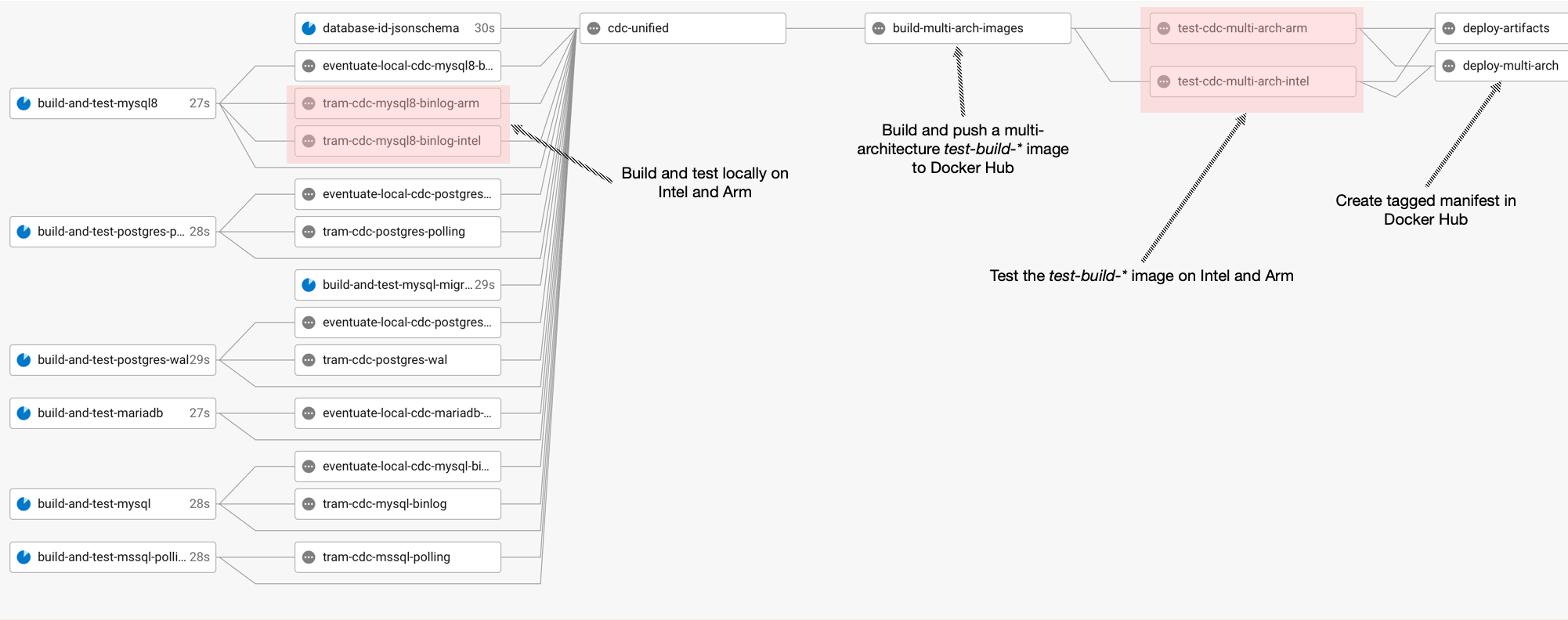Publishing a multi-architecture Docker image for the Eventuate CDC service
Contact me for information about consulting and training at your company.
The MEAP for Microservices Patterns 2nd edition is now available
The Eventuate CDC Service is a key part of the Eventuate Platform.
It plays the role of a Message Relay in the Transaction Outbox pattern.
It reads messages that are inserted in an OUTBOX table and sends them to the message broker.
It also reads inserted into an EVENTS table, which is part of Eventuate’s Event Sourcing implementation, and publishes them to Apache Kafka.
The Eventuate CDC service is a Spring Boot application that’s packaged as a Docker image.
This post describes how I changed the Eventuate CDC project to publish a multi-architecture Docker image.
The other articles in this series are:
- Part 1 - My Apple M1 MacBook: lots of cores, memory and crashing containers
- Part 2 - Building multi-architecture Docker images for Intel and ARM
- Part 3 - Configuring a CircleCI-based pipeline to build multi-architecture Docker images
- Part 4 - Testing an Intel and Arm multi-architecture Docker image on CircleCI
- Part 5 - Configuring CircleCI to publish a multi-architecture Docker image
- Part 6 - Developing the Eventuate Common library on an M1/Arm MacBook
- Part 7 - Configuring CircleCI to build, test and publish multi-architecture images for Eventuate Common
- Part 8 - Building a multi-architecture Docker image for Apache Kafka
- Part 9 - Publishing multi-architecture base images for services
- Part 11 - The Eventuate Tram Customers and Orders example now runs on Arm/M1 MacBook!!

About the Eventuate CDC project
The Eventuate CDC service supports multiple databases (MySQL 5, MySQL 8, Postgres, and MS SQL) and multiple message brokers (Apache Kafka, ActiveMQ, RabbitMQ and Redis). What’s more, for some databases, the CDC service supports both the Transaction log tailing and Polling publisher patterns.
In order to test all these variations, the project has a complex CircleCI deployment pipeline. The pipeline consists of two main sets of jobs. The first set of jobs test the various CDC modules with different databases and message brokers. The second set of jobs that build the CDC’s Docker image and test it with different databases and message brokers.
Changing the project’s CircleCI pipeline
I modified the project’s deployment pipeline to follow that the same four step pattern that I used for Eventuate Common:
- Build a multi-architecture Eventuate CDC image locally (using a registry container), and test the container it on both Intel and Arm.
- Build a multi-architecture Eventuate CDC image and push it to Docker Hub with a
test-build-*tag - Test the multi-architecture
test-build-*Eventuate CDC image on both Intel and Arm. - Create a manifest in Docker Hub with the desired tag
It’s important to note, however, that the pipeline only tests the multi-architecture image against MySQL 8 in order to minimize its execution time. Moreover, the pipeline jobs that run on an Arm machine only test against MySQL 8 and Apache Kafka because the project uses Intel-specific images for the other databases and message brokers.
Viewing the changes
To see the changes I made to the eventuate-cdc project, take a look at this Github commit.
Using the image
Once the project’s CircleCI pipeline was successfully publishing the multi-architecture image, I changed the Eventuate Tram Customers and Orders example application to use it. After making this change, my Apple M1 MacBook was able to successfully run the application’s tests. It can finally be used for development.


 Premium content now available for paid subscribers at
Premium content now available for paid subscribers at 




